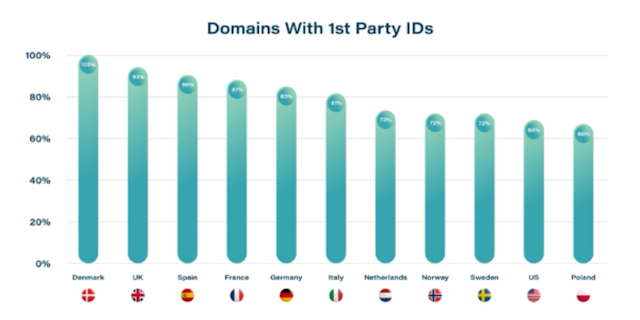CMOs: It’s time to step into the post-cookie world
The fact that third-party cookies will be deprecated by January 2022 is no surprise, but few are aware that first-party IDs already offer a viable alternative at high scale for personalized online advertising. Publishers are ready and have completely changed gear during 2021 with the overwhelming majority now passing first-party IDs in the bidstream, according to Adform data. Now it’s up to brands and their CMOs to ramp up adoption to future-proof supply chains.

Individual markets are at quite different stages of adoption
First-party IDs achieve bidstream parity
Adform analyzed the largest publisher domains representing 80% of total spend. The results show that not only are the vast majority passing first-party IDs, but the IDs are also being highly utilized. In fact, the volume of impressions being bought based on first-party IDs is close to reaching parity with third-party cookies across several European markets.
Individual markets are at quite different stages of adoption. Countries such as Denmark, the UK and Spain lead the way, with over 90% of publishers passing first-party IDs, while levels are around 70% in Poland, Sweden and Norway. In addition, publishers are not always sharing IDs on 100% of their traffic for two main reasons.
Firstly, some publishers are only sharing log-in based IDs which are limited to a portion of their traffic. This trend is evident in the US, where 68% of publishers share first-party IDs, but only on around 20% of the total impression volume because it’s primarily log-in IDs. Across Europe the picture is more positive with the majority being first-party cookies. These are set individually by publishers and naturally scale much higher across the entirety of the publisher’s traffic.
The second factor is more technical. Not all supply-side platforms (SSPs) support first-party IDs yet. This isn’t an insurmountable problem since most publishers use multiple SSPs, but it drags down the overall volume numbers.
Despite these variations, it is extremely encouraging to see first-party IDs scaling globally and publishers proving prepared for a world without third-party cookies. Now the time has come to pass the baton to brands and their CMOs to accelerate this momentum.

The ecosystem is ready for CMOs to take action
CMOs have the power to drive adoption of first-party IDs further and it is in their best interests to do so. The loss of third-party cookies has left marketers somewhat blinded so alternative solutions must be rapidly adopted. Otherwise, the benefits from targeting, tracking, frequency capping, measurement and optimization will be lost.
Purely relying on log-in IDs is also not a viable option for most marketers. As previously mentioned, these are only available for small parts of the web traffic. First-party server cookies, which are shared directly with ad tech vendors and in many cases stitched together on clicks or by using machine learning and probabilistic modeling, is the only fully scalable alternative to third-party cookies.
In addition to enabling effective ad execution and measurement, these first-party IDs have a number of other benefits for marketers. A first-party ecosystem will foster direct relationships and more transparency, with impressions fully traceable and accountable from end-to-end. This will dramatically reduce fraud, hidden fees and discrepancies.
Persistent first-party IDs, which usually last months or even years, enable better views on customer lifetime cycles compared with the week-long lifespan of the third-party cookie. For publishers, the longer living first-party IDs mean that first-party publisher data improves compared with the data collected through third-party cookie-based publisher DMPs today. In environments that have already phased out third-party cookies, such as Safari and Firefox, marketers are already seeing huge benefits from first-party IDs, such as a significant increase in both click-through and conversion rates.
What CMOs must do
With first-party IDs made available from most publishers and platforms such as Adform, CMOs need to act. They must ensure their ecosystem supports a range of IDs including first-party cookies and log-in IDs. By acting early, CMOs can ensure a seamless transition while future-proofing their supply chain. However, this transition will not be easy and will involve adapting technology and workflows such as new first-party tagging deployment and resetting old rule-of-thumb metrics like frequency capping or lookback windows. Another large task is revamping audience targeting strategies by mapping the availability of relevant audiences, since today’s third-party vendor data will need to shift to being primarily first-party publisher data.
Content by The Drum Network member:

Adform
Find out more
